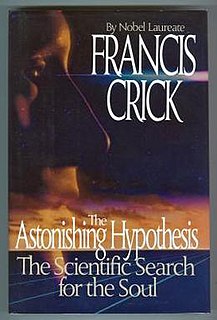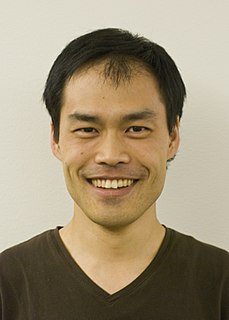Patrick Wilken (born 17 March 1966) is an Australian consciousness researcher. He was active in the promotion of consciousness studies and one of the founders of the Association for the Scientific Study of Consciousness.
He was born in Melbourne, Australia. He completed his doctoral studies at the University of Melbourne in 2001 under the supervision of Jason Mattingley and William Webster, where he developed models of visual short-term memory. He subsequently worked for three years as a postdoctoral fellow in the laboratory of Christof Koch at the California Institute of Technology, and then for two years as a postdoctoral researcher in the laboratory of Jochen Braun, at Otto-von-Guericke University of Magdeburg.
His primary research interest was limits in information processing within high-level vision. He argued along with his collaborator Wei Ji Ma that the capacity limits commonly seen in visual short-term memory and change blindness are caused, not by a high-level bottleneck in the number items that can be attended and/or stored in memory, but by an increase in neuronal noise in stimulus representations as complexity of visual information increases.
He has been active in the promotion of consciousness as an area of academic study since the early 1990s. In 1993, he founded the electronic journal Psyche (with Kevin B Korb, Monash Univ), which in addition to publishing peer-reviewed papers and book reviews, acted as an online forum for discussion of consciousness studies via its lively mailing list Psyche-D. He acted as editor-in-chief of the journal until 2002, when he handed over executive editorship to the philosopher Tim Bayne.
After attending the first Toward a Science of Consciousness meeting in Tucson in 1994, he promoted the idea of setting up a professional organization to organize future consciousness conferences. This idea grew into the Association for the Scientific Study of Consciousness. He has been active in the organization in various ways, including being a key organizer (along with William Banks) of both the first meeting of the association in 1997, and the most recent meetings organized with Christof Koch at Caltech 2005, Geraint Rees in Oxford in 2006 and Michael Pauen in Berlin in 2009. He sat on the Board of the ASSC from its foundation, and in 2002 took over from David Chalmers as its chair; later being appointed its first executive director.
In 2007, to avoid possible conflict of interest issues associated after he was appointed an editor at Cell Press (where he worked on the journals Neuron, Trends in Cognitive Sciencess and Trends in Neurosciences), he stepped down both as Director and from the Board of the ASSC. However, while at Cell Press he remained active with the ASSC (e.g., visiting Taipei twice to help the local organizers of the 2008 meeting). In late 2008, he quit his job at Cell Press, and relocated to Berlin, in order to co-organize the 2009 Berlin meeting of the ASSC. However, internal politics on the Board led to his being frozen out of further involvement with the organization he had helped to create at the completion of the meeting.
Computational neuroscience is a branch of neuroscience which employs mathematical models, theoretical analysis and abstractions of the brain to understand the principles that govern the development, structure, physiology and cognitive abilities of the nervous system.

Stuart Hameroff is an American anesthesiologist and professor at the University of Arizona known for his studies of consciousness and his controversial contention that consciousness originates from quantum states in neural microtubules. He is the lead organizer of the Science of Consciousness conference.

The Astonishing Hypothesis is a 1994 book by scientist Francis Crick about consciousness. Crick, one of the co-discoverers of the molecular structure of DNA, later became a theorist for neurobiology and the study of the brain. The Astonishing Hypothesis is mostly concerned with establishing a basis for scientific study of consciousness; however, Crick places the study of consciousness within a larger social context. Human consciousness according to Crick is central to human existence and so scientists find themselves approaching topics traditionally left to philosophy and religion.

Orchestrated objective reduction is a controversial hypothesis that postulates that consciousness originates at the quantum level inside neurons, rather than the conventional view that it is a product of connections between neurons. The mechanism is held to be a quantum process called objective reduction that is orchestrated by cellular structures called microtubules. It is proposed that the theory may answer the hard problem of consciousness and provide a mechanism for free will. The hypothesis was first put forward in the early 1990s by Nobel laureate for physics, Roger Penrose, and anaesthesiologist and psychologist Stuart Hameroff. The hypothesis combines approaches from molecular biology, neuroscience, pharmacology, philosophy, quantum information theory, and quantum gravity.
The binding problem refers to two problems of perception, used in neuroscience, cognitive science and philosophy of mind.
The electromagnetic theories of consciousness propose that consciousness can be understood as an electromagnetic phenomenon.

Christof Koch is a German-American neurophysiologist and computational neuroscientist best known for his work on the neural basis of consciousness. He is the president and chief scientist of the Allen Institute for Brain Science in Seattle. From 1986 until 2013, he was a professor at the California Institute of Technology.
Bernard J. Baars is a former Senior Fellow in Theoretical Neurobiology at The Neurosciences Institute in San Diego, CA., and is currently an Affiliated Fellow there.

Neural binding is the neuroscientific aspect of what is commonly known as the binding problem: the interdisciplinary difficulty of creating a comprehensive and verifiable model for the unity of consciousness. "Binding" refers to the integration of highly diverse neural information in the forming of one's cohesive experience. The neural binding hypothesis states that neural signals are paired through synchronized oscillations of neuronal activity that combine and recombine to allow for a wide variety of responses to context-dependent stimuli. These dynamic neural networks are thought to account for the flexibility and nuanced response of the brain to various situations. The coupling of these networks is transient, on the order of milliseconds, and allows for rapid activity.

Geraint Ellis Rees FMedSci is Dean of the UCL Faculty of Life Sciences, UCL Pro-Provost, UCL Pro-Vice-Provost (AI) and a Professor of Cognitive Neurology at University College London. He is also a Director of UCL Business and a trustee of the Guarantors of Brain.
The Association for the Scientific Study of Consciousness (ASSC) is a professional membership organization that aims to encourage research on consciousness in cognitive science, neuroscience, philosophy, and other relevant disciplines in the sciences and humanities, directed toward understanding the nature, function, and underlying mechanisms of consciousness.

The William James Prize for Contributions to the Study of Consciousness is an award given by the Association for the Scientific Study of Consciousness.
The Mind Science Foundation (MSF) is a private non-profit scientific foundation in San Antonio, Texas, USA, established by the philanthropist Thomas Baker Slick in 1958.
In neuroscience the bridge locus for a particular sensory percept is a hypothetical set of neurons whose activity is the basis of that sensory percept. The term was introduced by D.N. Teller and E.Y. Pugh Jr. in 1983, and has been sparingly used. Activity in the bridge locus neurons is postulated to be necessary and sufficient for sensory perception: if the bridge locus neurons are not active, then the sensory perception does not occur, regardless of the actual sensory input. Conversely if the bridge locus neurons are active, then sensory perception occurs, regardless of the actual sensory input. It is the highest neural level of a sensory perception. So, for example, retinal neurons are not considered a bridge locus for visual perception because stimulating visual cortex can give rise to visual percepts.
Axel Cleeremans is a Research Director with the National Fund for Scientific Research (Belgium) and a professor of cognitive science with the Department of Psychology of the Université Libre de Bruxelles, Brussels.
Flash suppression is a phenomenon of visual perception in which an image presented to one eye is suppressed by a flash of another image presented to the other eye.

The neural correlates of consciousness (NCC) constitute the minimal set of neuronal events and mechanisms sufficient for a specific conscious percept. Neuroscientists use empirical approaches to discover neural correlates of subjective phenomena; that is, neural changes which necessarily and regularly correlate with a specific experience. The set should be minimal because, under the assumption that the brain is sufficient to give rise to any given conscious experience, the question is which of its components is necessary to produce it.
Anthony M. Zador is an American neuroscientist and the Alle Davis Harris Professor of Biology and Chair of Neuroscience at Cold Spring Harbor Laboratory. He is a co-founder, in 2004, of the Computational and Systems Neuroscience (COSYNE) conference, and of the NAISYS meeting about the intersection of neuroscience and artificial intelligence. Dr. Zador's research has focused on understanding the circuits of the auditory cortex in rodents. More recently, he has pioneered a new approach to connectome mapping using the methods of molecular biology, which may dramatically decrease the cost and improve the speed of mapping neuronal circuits at the single cell level.

Wei Ji Ma is a professor at New York University in the Department of Psychology and the Center for Neural Science. Ma focuses on the areas of perception, decision-making, and memory. He holds a PhD in theoretical physics from University of Groningen in the Netherlands. Ma is the 2021 recipient of the Jeffrey L. Elman Prize for Scientific Achievement and Community Building from the Cognitive Science Society.
Yujin Nagasawa is a Japanese-born British philosopher specialising in the philosophy of religion, the philosophy of mind and applied philosophy.